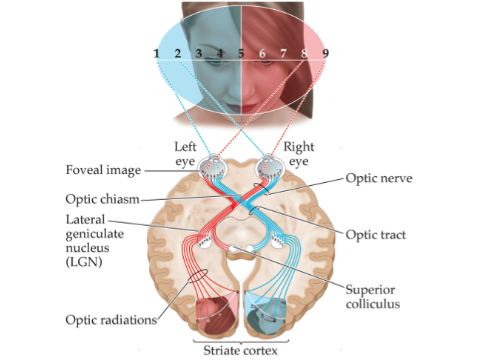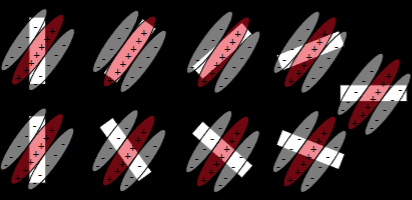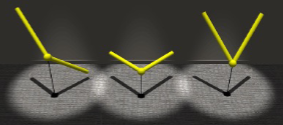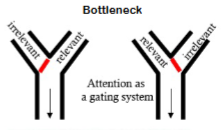Human Perception Exam 2
1/58
There's no tags or description
Looks like no tags are added yet.
Name | Mastery | Learn | Test | Matching | Spaced |
|---|
No study sessions yet.
59 Terms
retina circuitry
sensitivity and resolution.
many-to-one convergence
promotes sensitivity.
one-to-one convergence
promotes spatial resolution.
overview of visual processing
light enters the eye —> retina converts light into signals —> signals travel to brain —> brain interprets the image —> ability to see!
excitatory-center, inhibitory-surround RF
on-center ganglion cell.
inhibitory-center, excitatory-surround RF
off-center ganglion cell.
function of the center-surround receptive field
detecting a spot of light and detecting a edge of a stimulus.
parasol ganglion cell
magno-cellular pathway.
color blind.
FAST (temporal frequency).
HIGH contrast sensitivity.
LOW spatial resolution.
midget ganglion cell
parvo-cellular pathway.
color selective.
SLOW (temporal frequency).
LOW contrast sensitivity.
HIGH spatial resolution.
retinotopy
mapping of visual input of the retina neurons, particularly those neurons within the visual stream.

cortical magnification
foveal area is about 0.01% of whole retina, but signals from the fovea account for 8 to 10% of the retinotopic map on the cortex.

orientation selectivity
orientation tuning of a “simple cell” in V1.
we need an elongated receptive field.

cortical organization
columnar structure for orientation and ocular dominance.

selective adaption technique
when we view a stimulus with a specific property, neurons tuned to that property fire, and if viewing continues for long enough, these neurons adapt.
effects of adaption
decrease in firing rate of the adapted neuron.
decrease in sensitivity when the adapting stimulus is immediately presented again.
selective adaption to orientation
researchers test orientation adaptation by first measuring a person’s sensitivity to various line angles. After the person stares at a line tilted in one direction for one to two minutes, their sensitivity is measured again. If adaptation occurs, sensitivity to the viewed orientation should decrease, while sensitivity to other angles remains unchanged.
ventral and dorsal streams
“what” and “where” pathways.
object discrimination problem
object recognition.
landmark discrimination problem
relative location.
“where” pathway
integrating with an object involves knowing the location of the object.
“how” pathway
dorsal stream involves in how to direct actions for interacting with objects in environments.
neuropsychological study showing how-pathway
behavior of patient D.F.
single dissociation
cannot make an orientation match, but can put a card into an oriented slit.
double dissociation
a patient whose symptoms are exactly the opposite to D.F. can be founded.
modularity
the structures located along the ventral and dorsal pathways are often specialized to process information about specific visual qualities.
fundamental spatial information
orientation
contrast
spatial frequency
spatial phase
spatial frquency
building blocks of visual images.
gestalt approach
perception is created by combining elements called sensation.
(this doesn’t explain several perceptual phenomena such as Apparent Motion and Illusory Contour).
the whole differs from the sum of its parts
perception is not just created by combining elements, perceptual organization creates a “whole” from small parts.
properties of figure and ground
figure is object-like and in front of the ground.
ground is uniform region behind the figure.
both share a contour (boarder ownership).
heurisitics
rules of thumb that provide a best-guess solution to a problem.
algorithm
a procedure that is guaranteed to solve a problem.
likelihood
we perceive the object that is most likely to have cause the pattern of stimuli.
why is visual recognition hard?
difference sizes, 2D orientation, 3D views, and exemplars.
inverse projection problem
different objects can give rise to the same retinal image.

template model
simple and intuitive, but lacks flexibility.
some limits are the massive number of templates are required.
a possible solution is the Feature-Based Model.
feature-based models
fixed set of elementary properties analyzed independently in parallel across visual field.
a limit is different objects share the same features and relationships.
recognition by component theory
objects are represented by a small set of geons and their relationships.
configural and holistic face processing
better at recognizing a face part (i.e. nose) if presented in context of a face (holistic).
specialized modules (nancy kanwisher)
specialized bran areas for processing certain stimuli: face, places, bodies (sparse coding).di
distributed representations (jim haxby)
faces and objects represented by distributed patterns of activity in ventral temporal cortex.
expertise (isabel gauthier)
fusiform area important for expert processing: subordinate-level recognition, not face recognition.
fusiform face area (FFA)
module specialized for faces since it responds more to faces than to:
common objects.
scrambled faces.
houses.
hands.
flowers.
distributed representations theory
Design: subjects viewed 1 of 8
categories of stimuli.
Results: activity patterns in
ventral temporal cortex
measured from first 1/2 of EXP
could accurately predict what
object category was seen in
2nd half of EXP 96% accuracy
(chance 50%).
cognitive resources
a person has a certain cognitive capacity, which can be used for carrying out various tasks.
cognitive load
the amount of a person’s cognitive resources needed to carry out a particular cognitive task.
multiple object tracking
people (even 5yo children, though not most professors) can track 4 to 5 individual objects that have no unique visual properties.
broadbent (1958)
attention works like a bottleneck of information processing stream.

late selection theory
selection occurs at the late stage of information processing (the bottleneck located later in the processing, after meanings of the messages have been extracted).
divided attention
can be achieved with practice.
automatic processing
can be achieved if the relationship between target and distractors keeps changing.
controlled processing
need a lot of cognitive resources.
covert attention
without eye movement.
spotlight metaphor
cover only small spatial region, fuzzy boundary.
location-based attention
visual attention is directed to a particular location in the visual scene.
posner (1980)
spatial cueing; target detection is faster and more accurate with valid cue.
object-based attention
visual attention is directed to objects or perceptual groups of visual scene previously segmented on the basis of gestalt principles.
balint’s syndrome
cause: bilateral parietal damage.
effect: patient can only perceive one object at a time.
feature integration theory
focused attention have a major role for binding features to achieve a representation of an object.